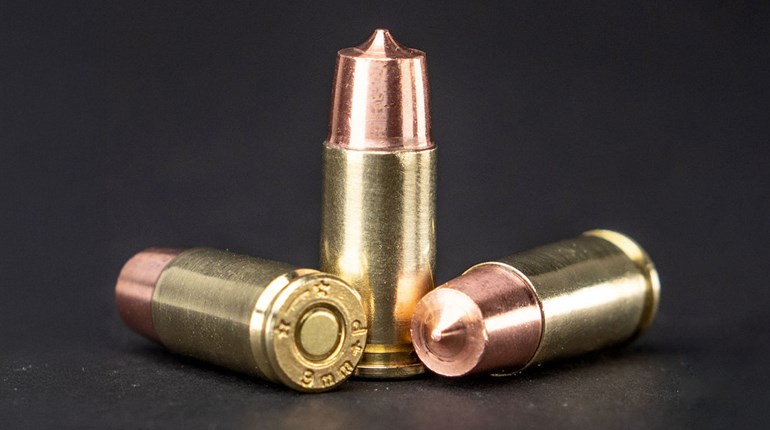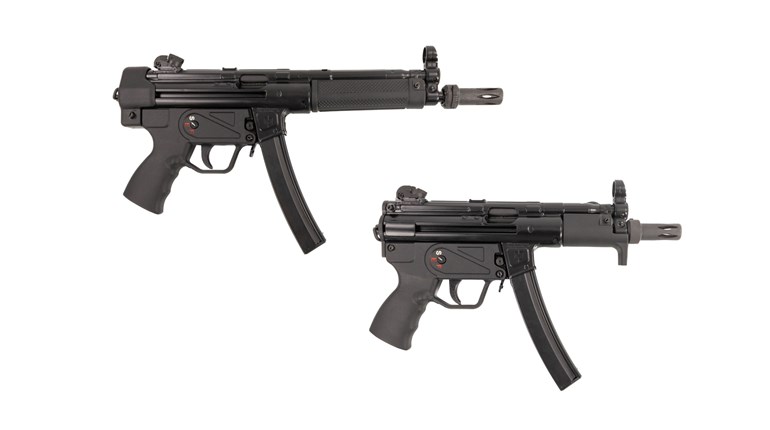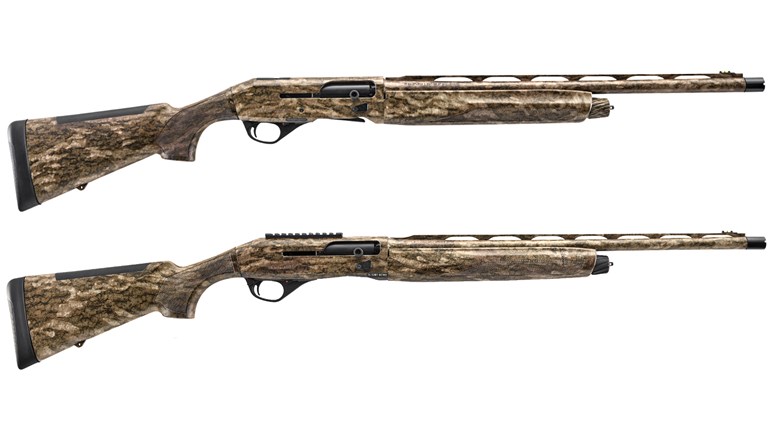
If I could use only two words to describe the original Smith & Wesson M&P semi-automatic pistols, those words would be "superb ergonomics." And if you were to object with my conclusion because the gun didn't fit your hand, I would simply tell you to switch backstraps until it did. Among the three different size backstraps provided with the gun, there's one that will fit just about everyone.

In whatever chambering you choose (9 mm, .40 S&W or .45 ACP) the original M&P makes a great duty, home-defense or car/truck gun. Concealed carry, however, is a different matter. For many of us, pistols using double-stack magazines aren't that easy to conceal, at least not if we're going to move about in society and look reasonably normal. Cutting the wide-body pistol down in length and height may help, but that alone doesn't get the job done.
Of course, the obvious way you make a double-stack pistol skinny is to make it a single-stack. But when you do that, you raise the question as to whether or not you've maintained the superb ergonomics and handling characteristics of the original gun. Smith & Wesson took the challenge and redesigned the M&P to make it skinny. The result is the new M&P Shield, a single-stack, compact M&P in 9 mm, with a .40 S&W to follow soon.
You'll have no trouble recognizing the Shield's ancestry. It has the polymer frame with textured grip surfaces, the stainless steel slide with the ultra durable black Melonite finish and the large external extractor on the starboard side.
Unlike its bigger cousins, the Shield does not have an integral accessory rail, but given its 3-inch barrel and concealed-carry mission, I don't consider that a shortcoming. There are wavy serrations at the rear of the slide that look a bit like snake scales, but give excellent purchase when manually cycling the gun or running a chamber check. I mention chamber check because although the Shield has a visual loaded-chamber indicator, it is very difficult to see the cartridge rim in conditions other than bright daylight. Also, if you're getting farsighted, a manual slide retraction and verification of a chambered round is mandatory.
The textured finish on the grips feels exactly like the grips on the larger M&Ps, and the pattern is identical. The difference is the Shield has a fixed or integral backstrap. Smith & Wesson was focused on making the Shield compact, so there are no larger interchangeable backstrap options. The Shield has the same L-shaped lip at the base of the backstrap, which looks like that on the full-size model. When a magazine is inserted into the gun, it fits flush, making the base of the grip frame flat. Sights are the same drift-adjustable, three white-dot system used on the big guns. Similarly, both front and rear sights are solidly dovetail mounted into the top of the slide.
All controls are mounted on the left side of the frame on the larger-frame M&P variants, but the slide stop on the Shield does not extend through the frame, a feature that makes it ambidextrous on the larger M&Ps.

Closest to the muzzle and above the trigger is the rotating takedown lever. Moving rearward into the grip frame and located above the trigger is the slide stop. Near the back of the frame, just under the wavy slide serrations, is the thumb safety. All of the controls are quite flat, protruding only slightly from the gun's frame. I thought this would be a detriment to operating the thumb safety during the draw stroke, but it turned out to be much easier than I thought. Under the heightened excitement of an attack, however, manual dexterity may suffer and a reliable thumb-safety release could become quite problematic.
The answer is simple: Keep the safety off when holstering. The reality is most striker-fired handguns don't have an external safety that requires manual deactivation distinctly separate from pulling the trigger. In fact, the thumb safety on the larger M&Ps can be removed from the pistol and the gun will still function perfectly—not so on the Shield. Its thumb safety is installed for the duration.
The advantage to having a manual safety on the M&P is, with the safety engaged, the gun can do everything except fire. Cycling the slide, chamber checks, magazine removal and reloading are all possible with the safety engaged. My house gun is a full-size M&P45 with the external safety installed.
I carried the Shield for several days with the thumb safety in the off position. My feeling is an M&P on my person, under my control, doesn't need an external safety, but if it has one, I would comfortably carry it with the safety off. For my house gun, the external safety stays in the "on" position when stored. How you choose to carry or store the gun is a choice you have to make, and it must be a choice with which you're comfortable.
The Shield comes with two magazines. One holds seven rounds and the other holds eight. Being about .25 inch longer, the eight-round magazine provides longer grip length and includes a sleeve around the metal portion of the magazine. This sleeve has the same texture as the pistol's grip and maintains the grip's contour and pattern down to the magazine's base pad. It doesn't feel like a longer magazine or magazine extension, but rather like a longer grip frame. Unlike on the short magazine, the shape of the sleeve creates a "lip" at the rear of the higher-capacity model rather than on the front. The end result is you may be fighting a tendency to insert the magazine backward into the mag well and your mag pouch, resulting in the bullets facing the wrong direction. You'll overcome this quickly, but the easiest solution is to insert the loaded magazine into your magazine pouch in the same position as when you withdraw the magazine for a reload, i.e., with the left hand "trigger" finger on the nose of the first round. The other procedure you must learn with the Shield's longer magazine is to verify the sleeve is flush against the base pad after you've inserted it into your pouch. When you push down on the magazine to insert it, there is a chance you will push the moveable sleeve down and away from its base pad. When inserting a magazine, the improperly located sleeve can prevent it from completely seating in the mag well, resulting in a magazine that is not fully locked in. One other caveat, with short-grip-frame concealed-carry pistols, is you can pinch your overlapping palm during a vigorous magazine change that finishes with a Paul Bunyan-like seating slap. I'm pleased to report the Shield was much more forgiving in this regard than other ultra compacts I've used in the past.
Some good things surfaced during the shooting sessions. With its slimmer slide—machined from solid bar stock like the bigger models—the Shield weighs 19 ounces unloaded. That's considerably more than a scandium-frame Smith & Wesson J-frame revolver, but it's a weight difference you'll appreciate when you fire 9 mm self-defense ammo, particularly +P loads, which the Shield digested easily. The weight and the high grip facilitated control of the gun during rapid-fire strings. I thought the trigger felt a bit more crisp than on earlier models of the full-size guns, but that could be a matter of my perception, having spent a good deal of trigger time at Gunsite with multiple M&Ps.
A gunwriter friend, who is also an instructor, ran a couple boxes of ammo through the Shield and included some weak-hand shooting drills. He was favorably impressed and quite complimentary of the pistol's virtues.

I don't like to conduct accuracy tests on compact pistols at 25 yards because I consider that range beyond its primary mission profile. But since the Shield has the same sights and trigger as other M&Ps I've used, I decided to try. My shooting was performed while seated under an awning at a shooting bench with my wrists (but not the gun) resting on a bag. At 25 yards, I posted light-grey bullseye-style targets, because they provided a softer contrast for the sights and helped me see more light around the front blade. In addition, I was wearing DeCot shooting glasses with a magnifying insert in the lens of my shooting eye in order to clearly focus on the front sight.
The Shield shot to point of aim with the 147-grain loads. All groups were comprised of five shots, but many had one shot that essentially doubled the group size made by the other four. That probably speaks to a lack of concentration on my part, while suggesting a greater accuracy potential than I was able to demonstrate. Even counting all five shots in the group sizes, the little gun is more than adequate for self-defense out to 25 yards. Perhaps even more important, there were absolutely no stoppages or malfunctions of any kind.
I carried the Shield and spare magazine for several days in Galco's Stinger belt holster and concealable magazine case. Covered by a loose shirt, it was a case of maximum comfort, total concealability and easy accessibility. Based on other handguns carried in this fashion, I think this skinny M&P variant could be more easily concealed and carried with almost as much comfort in an IWB holster, although I have yet to try.
The Shield has some potential as a pocket pistol, depending on your pockets. In the jeans I was wearing, the front pocket had ample room to accommodate the pistol, but the opening was restricted, so it was difficult to access and withdraw the gun—kind of like the gorilla trap where a banana is placed inside a box that can only be accessed through a small hole. The hole is large enough so the gorilla can get his hand in with his fingers extended, but once he has grabbed the banana, he can't get his fist back out through the hole. If I get a chance to try the pocket carry technique later, it will definitely be with a pocket holster, because I have real reservations about carrying any semi-automatic in a pocket without the controls (including the trigger) being covered and protected.
If you haven't guessed, I'm very impressed with the Shield's potential for concealed carry. It extends the range at which I can solve problems well beyond that of most pocket pistols. With just one spare magazine, I'm equipped with 16 rounds of high-performance 9 mm ammunition. In other words, one fast reload translates to more than three cylinders of .38 Spl. or .357 Mag. If your concealed-carry Shield becomes your home-defense handgun at the end of the day, you will be armed with a pistol that will adequately reach the length of any average household hallway. What's not to like?
Specifications
Manufacturer: Smith & Wesson; (800) 331-0852
Action Type: Striker-fired, semi-automatic
Caliber: 9 mm
Capacity: 7+1 and 8+1
Frame: Polymer
Slide: Melonite-coated stainless steel
Barrel Length: 3.1 inches
Rifling: 5 grooves: 1:10-inch RH twist
Sights: Drift-adjustable front and rear, with three white dots
Trigger Pull Weight: 7 pounds
Length: 6.1 inches
Width: .95 inch
Height: 4.6 inches
Weight: 19 ounces
Accessories: Owner's manual, two magazines
MSRP: $449
Shooting Results
| Load | Velocity | Average Group Size |
| Black Hills 115-grain JHP | 1,205 | 3.5 |
| Cor-Bon 90-grain JHP | 1,463 | 3.3 |
| DoubleTap 80-grain JHP | 1,239 | 6.0 |
| Hornady 125-grain HAP | 996 | 3.3 |
| Hornady 147-grain HPXTP | 930 | 4.5 |
| SBR 124-grain JHP | 1,005 | 5.0 |
| SBR 147-grain JHP | 836 | 3.1 |
Velocity measured in fps for 10 consecutive shots with a Shooting Chrony chronograph 10 feet from the muzzle. Temperature: 73 degrees Fahrenheit. Accuracy measured in inches for five consecutive, five-shot groups from a sandbag rest at 25 yards.






































